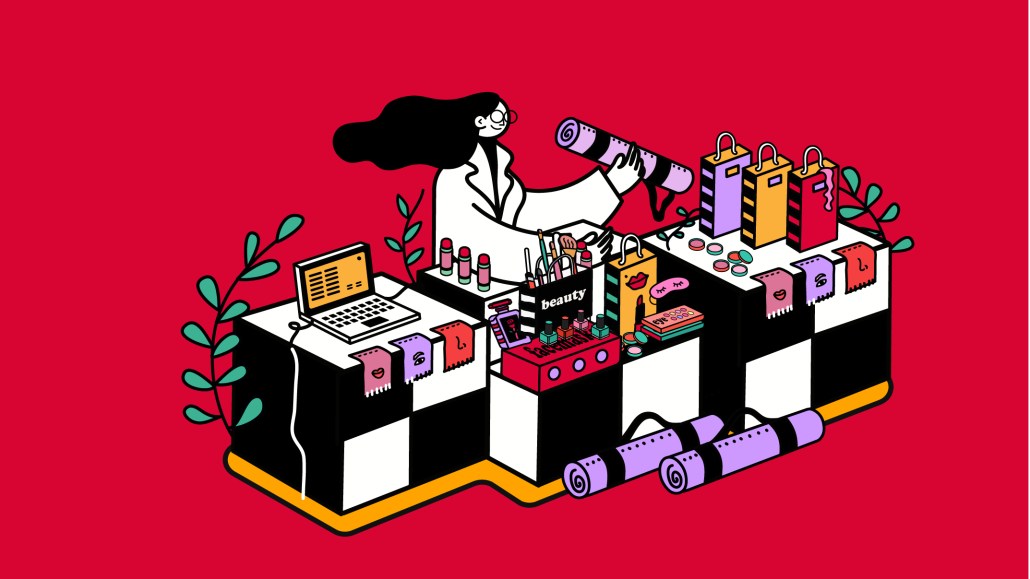Save 50% on a 3-month Digiday+ membership. Ends Dec 5.

Entrepreneur and reality star Kim Kardashian is using QR codes in a new ad for her skincare brand Skkn by Kim — a move made in partnership with technology company Flowcode that she hopes will help the six-month-old brand foster long-term relationships with consumers.
Kardashian will continue to utilize her organic social media following to pitch the new brand to consumers, a strategy similar to that of WWE Superstars Mandy Rose and Sonya Deville when they launched their direct-to-consumer donut brand. At the same time, Kardashian’s Skkn by Kim rolled out its first 30-second ad spot this month on connected TV platforms Hulu and YouTube, linear TV cable network E!, as well as on the brand’s TikTok, Instagram, LinkedIn, Twitter and Facebook pages. The ad will also appear via kiosks and digital displays, all of which will feature QR codes facilitated by Flowcode. The financial agreement between Skkn by Kim and Flowcode to launch the partnership was not disclosed.
Working with Flowcode positions Skkn by Kim for connecting “with our consumers, driving purchases and measuring the impact of the campaign with real-time analytics,” Kardashian told Digiday. The brand’s target audience for the QR code campaign is 18-to-55-year-old women who have an interest in skincare, beauty and fashion.
According to Kardashian, roughly 90% of the ad spend for the campaign is dedicated to streaming and linear TV, with the rest going toward out-of-home. With that said, it’s a 360-degree campaign that includes in-store, outdoor, TV and social placements, with the majority of the ad spend taking place on TV and digital channels, since those are the places Skkn By Kim’s consumers are spending their time.
“Our goal with this campaign was to meet customers where they are to drive brand conversions and capture CRM for the brand,” said Kardashian.
In addition to the ad spot, the brand promoted its skincare through holiday pop-ups at the Westfield Century City mall in Los Angeles last month to encourage shoppers to sign up to be part of Skkn by Kim’s community and get sneak peeks of new launches as well as exclusive benefits such as early access to new products.
For Skkn by Kim’s QR code campaign, recent privacy changes factored into the brand’s decision to partner with Flowcode. “Our trust in the privacy of Flowcode’s platform was a big factor in this partnership and they are the safest QR platform and the only GDPR and CCPA compliant company on the market,” Kardashian said.
Ad position: web_incontent_pos1
When taking privacy into account, QR codes offer Skkn by Kim and other brands an effective way to experiment with how they reach customers. In fact, 45% of shoppers in the U.S. had used QR codes for marketing purposes within the last three months as of last summer, according to a survey by Statista.
“QR codes allow users to connect with brands they want to know better, and brands get access to the interested customers through pixels for Facebook, TikTok and Google ad retargeting,” said Lauren Petrullo, founder of digital marketing agency Mongoose Media. “It allows for personalized advertising when layered in with GeoLocation settings and customer data from purchases made in person and a week prior.”
As Skkn by Kim expands its product line in 2023, the brand is keen on entering new categories, as it did with its recent launch of home accessories with the goal of creating a seamless experience in which customers can purchase all of the brand’s offerings on its website. “We hope to continue to develop and expand our product range with expertly-crafted and universally-loved products that are performance driven and fill gaps in the market,” said Kardashian.
More in Marketing

Ulta, Best Buy and Adidas dominate AI holiday shopping mentions
The brands that are seeing the biggest boost from this shift in consumer behavior are some of the biggest retailers.

U.K. retailer Boots leads brand efforts to invest in ad creative’s data layer
For media dollars to make an impact, brands need ad creative that actually hits. More CMOs are investing in pre- and post-flight measurement.

‘AI is permeating everything we do’: How Guitar Center developed 2 AI tools this year
This summer, the company launched a chatbot called Rig Advisor to help customers find the right instruments and products.
Ad position: web_bfu



